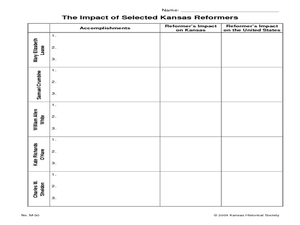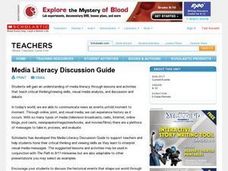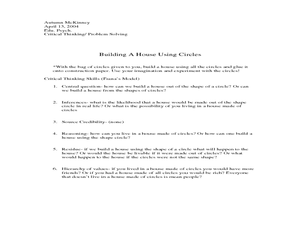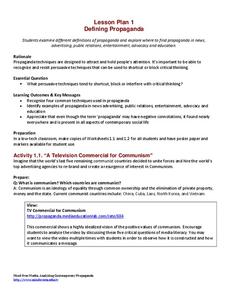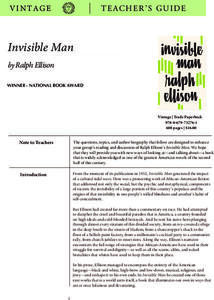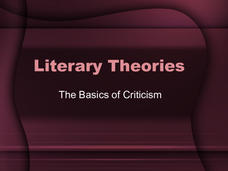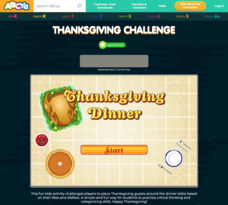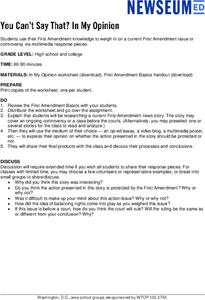Curated OER
Problem Solving---A Part of Everyday Thinking
Students demonstrate knowledge of the six basic steps to problem solving. They demonstrate ability to apply these six basic steps to problem solving by guiding other students in the solution of a given problem or set of problems.
Curated OER
From Greece to Main Street
Students consider the influence of the Greeks on American architecture. In this American Greek Revival architecture lesson, students identify the attributes of architectural style as they compare the Parthenon with the Lincoln Memorial....
Curated OER
Ravishing Rings (Multiplication with a Snack)
Students understand multiplication through the use of snack manipulatives. In this multiplication instructional activity, students solve a multiplication problem using pretzels and then create and answer original problems. Students...
Curated OER
The Cask of Amontillado
Students examine the Edgar Allan Poe story "The Cask of Amontillado." For this character lesson, students discuss and analyze the characters in the story. Students make personal connections to the characters and create a brochure...
Curated OER
Meet the Reformers
Seventh graders interpret historical evidence presented in primary and secondary resources. In this American reformers lesson, 7th graders research the accomplishments of selected reformers. Students then use the information they uncover...
Curated OER
The Underground Railroad
First graders read a book about Harriet Tubman and the Underground Railroad. In this underground railroad lesson, 1st graders learn songs and code words that the slaves used to communicate with one another. Students discuss how all...
Curated OER
Media Literacy Discussion Guide
High schoolers examine and analyze visual media and its messages critically. They determine whether specific media messages inform, entertain, or persuade and what factors influence the media. Using primary sources, they participate in...
Curated OER
Presidential Election 2008:Making Decisions about Political Candidates
Students think critically about political candidates. In this election lesson, students research candidates and use information sources to explore their stands on issues.
Curated OER
Balance Benders - Algebraic Reasoning
In this algebraic reasoning learning exercise, students solve 4 multiple choice and true/false problems. Students determine which statements about equality are true. Students find the appropriate representation of a given symbol in terms...
Curated OER
Cooperative Problem Solving Tasks
Fourth graders explore the following activities where kids are encourage to think creatively, share thoughts and opinions, create, discuss and solve problems, and than draw conclusions.
Curated OER
Building a House Using Circles
Students study circles and problem solving. In this critical thinking lesson, students build a house using all of the circles given to them gluing them onto paper.
Media Education Lab
Defining Propaganda
21st century learners live in a media world. Help them develop the skills they need to be able to analyze the barrage of propaganda they face daily, with a resource that introduces them to the type of persuasive appeals found in news,...
Penguin Books
Teacher’s Guide: Invisible Man by Ralph Ellison
Ralph Ellison's Invisible Man tops the reading list for the AP Literature exam. A five-page guide offers instructors and book clubs discussion questions designed to get readers to think deeply and critically about the inspection of...
Livaudais-Baker English Classroom
Literary Theories
Introduce ELA scholars to the basics of literary criticism with a 41-slide presentation that identifies eight different approaches to critical analysis. Each approach is defined, and advantages and disadvantages are listed. Also included...
K20 LEARN
Street Cred: Evaluating Sources
A instructional activity on evaluating sources of information teaches scholars to "think twice" before using a source. Researchers examine a resource's home page, author, and sponsor, as well as the date published and the documentation...
Curated OER
Cartoons in the Classroom: Doves, Flags, and Bombs
A political cartoon is timely and thought-provoking. Learners analyze the symbolism found in the cartoon as it relates to current tensions between North and South Korea. Three in-depth analysis questions guide and stimulate class...
ABCya
Thanksgiving Challenge
Set the Thanksgiving Day holiday table with a learning game that challenges participants to think critically about family members' likes and dislikes. Players scroll over a character to reveal what the requirements are for their seating...
Nemours KidsHealth
Online Safety: Grades 9-12
Teach teens how to protect themselves from hackers, scammers, and online predators. First, class members examine their own digital footprints think critically about their online profile. Groups then generate lists of "do" and "don't do"...
Nemours KidsHealth
Online Safety: Grades 6-8
Recognize risky behaviors and avoid them! That's the big idea behind two activities designed to teach middle schoolers to think critically about online safety. After reading background articles about protecting online identity,...
PBS
Compare State Voting Laws Today with Laws of the Jim Crow Era
Georgia's law S.B. 202 is at the center of a lesson that asks young scholars to examine what critics say are Georgia's attempts to limit voting access to Black voters. Groups then investigate the voting laws in their own state, as well...
Nemours KidsHealth
Screen Time: Grades 6-8
How much screen time is too much screen time? Even before COVID, tweens were spending hours watching TV, playing video games, and connecting with their friends by smartphone and computers. Two activities from Kids Health get young...
Academy of American Poets
Teach This Poem: "Spring is like a perhaps hand" by E. E. Cummings
E. E. Cummings' "Spring is like a perhaps hand" offers young scholars an opportunity to try their hands at analyzing a simile. After a warm-up activity and a close reading of the poem, class members discuss what they think the poem is...
Newseum
You Can’t Say That: In My Opinion
As a part of a study of the First Amendment, high schoolers research a current news story that seems to involve one of the freedoms granted by the First Amendment. Investigators decide whether they think the action presented in the story...
Nebraska Department of Education
Goal Maps
High school freshmen are asked to think about their future goals and reflect on what they have learned about the barriers they may face and the resources they have to overcome these barriers. Individuals then respond to questions on a...






